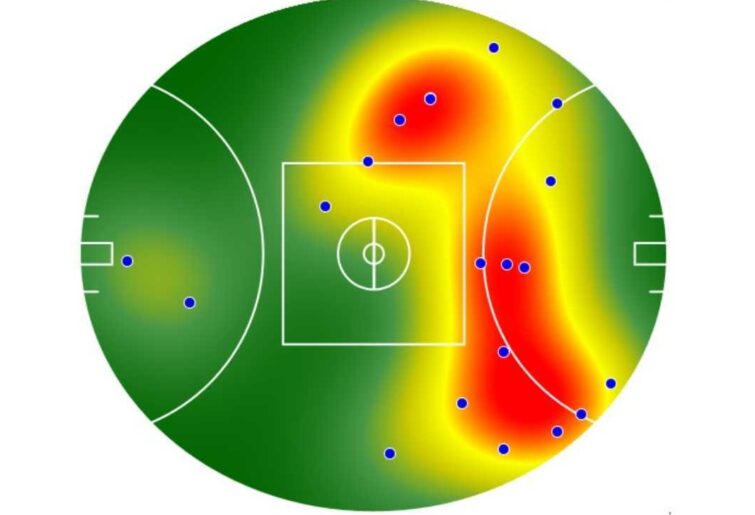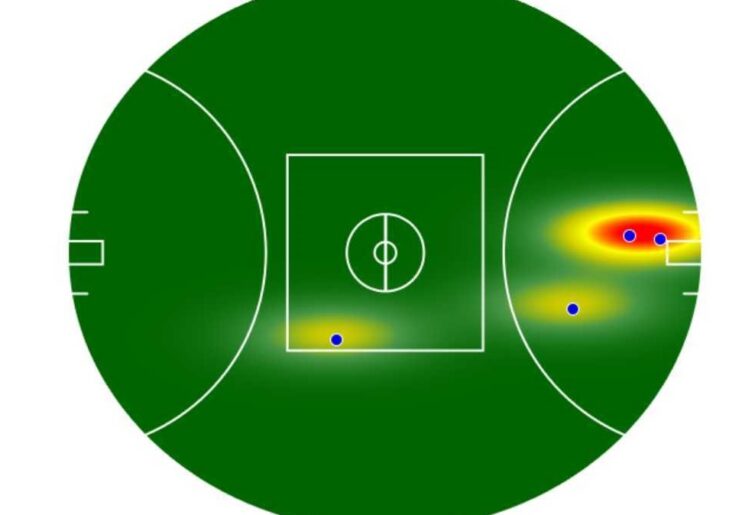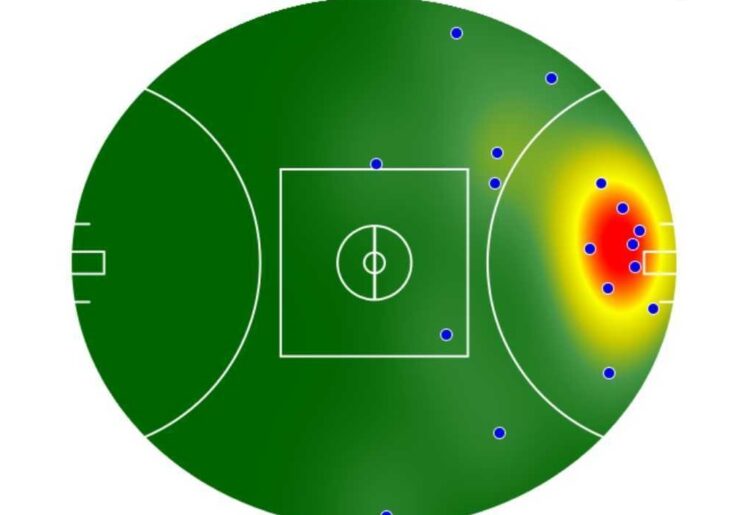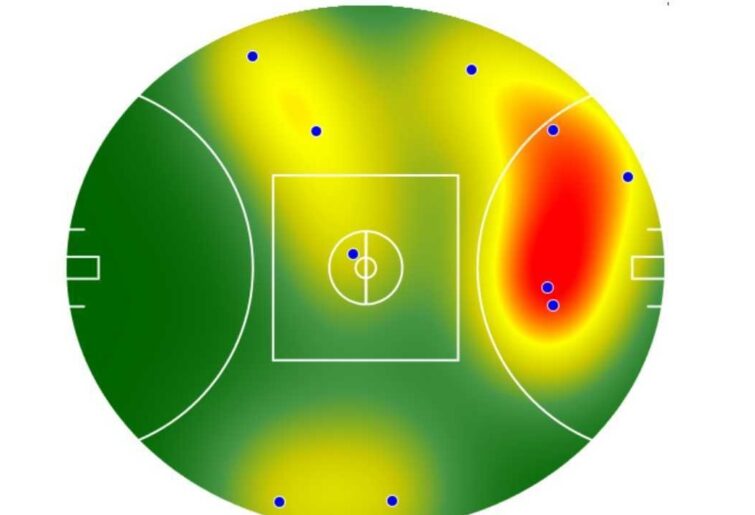Gold Coast have had a handful more significant wins in their 11 and a half years in the AFL than the come-from-behind 25-point triumph they enjoyed over Adelaide on Saturday night.
Just last year, Noah Anderson kicked truly after the siren to mark a famous victory over Richmond. Go back to 2014, and you’ll find the Suns, with no fit men on the bench in the last quarter and the great Gary Ablett nursing a busted shoulder, hanging on for grim death to beat Collingwood by five points in a match which seemed at the time like the dawn of a powerhouse.
For a time, they made a yearly habit of beating Sydney in Sydney, too, long one of footy’s toughest asks.
But at no point across 271 games of occasional highs and ocean abyss lows have the Suns played finer football than they did to best the Crows in Darwin. Having gone 35 points down midway through the second term and looking on track for another of those typical Gold Coast abject performances that undo week upon week of lifting themselves out of the muck, the next two and a half quarters were nothing short of magnificent.
The Suns under Stuart Dew have long been capable of grinding out the occasional upset win against the odds, dragging teams down to their scrappy level and then beating them with experience, but this was a win of far more substance than those. Gold Coast, against the most menacing, high-octane forward line in the AFL, a team that moves the ball with dash, dare and freedom unlike just about anyone this side of Collingwood… beat Adelaide in a shootout.
Part of what makes the Suns great is that they, to my eye, have the simplest game plan in footy; and one made even simpler in the greasy, humid conditions that Darwin has offered in their past two weeks.
It is one excellently aligned with the attributes their playing group has, and on nights where it all clicks, like Saturday night at TIO Stadium, it is gorgeous to watch.
To begin with, the Suns are relentless at the coalface. The plan is simple: scrap and scrounge for the ball until it’s won, and tackle and harass like your life depends on it when the opposition picks it up.

Ben King of the Suns celebrates a goal. (Photo by Dylan Burns/AFL Photos via Getty Images)
At the conclusion of Round 11, the Suns in 2023 were behind only Brisbane for clearances won, and narrowly third behind Melbourne and St Kilda for contested possessions. Winning the hard ball is second nature for tough nuts like Matt Rowell (13 contested possessions, 10 clearances) and Noah Anderson (18 and 8); while Dew has found a gem in top draftee Bailey Humphrey too. Injected into the on-ball brigade on a permanent basis against the Bulldogs last week, the young gun is relishing the extra responsibility, with his 12 contested possessions already the fifth-most on the ground.
This group is why the Suns get an unmatched 43 per cent of their possessions this season in a contest: they prioritise what they’re good at, and try to make every game as hotly congested as possible.
Helping the Suns out at stoppages surely must be the set roles they have; criticised earlier in the season for having limited midfield options, especially at centre bounces, I can only see it as a strength in their current form.
You almost never see a centre bounce now without Rowell and Anderson snapping at the heels of ruckman Jarrod Witts, while the third midfield role is divided neatly these days between Humphrey and David Swallow, the latter of whom doesn’t win as much of the ball anymore but made up for it against the Crows with seven crunching tackles.
Everyone has a directive to go for the hard ball, to the point where they’ll occasionally get in each other’s way; but in means when the temperature is hottest, the Suns will almost certainly have more willing combatants than any opponent they’re likely to face. And that bodes well for finals, if and when they finally cross that threshold sometime soon.
That group helped wallop the Crows 174-136 for contested possessions, just as they had to the Dogs (158-141) the week prior. Only four times all year have the Suns lost that count, with Brisbane in Round 10 the only time they’ve been soundly beaten for the hard ball.
Four of the seven consecutive goals the Suns scored across the second and third terms against the Crows came from stoppages. That’s a remarkable number in a game where the majority of points are nearly always generated via turnovers.
Hampered into submission at first by the Crows’ frenetic pressure at the contest – by quarter time, Adelaide had a pressure rating of 207, continuing their trend of starting games hot – the Suns found the Crows incapable of sustaining that in the Darwin humidity, conditions unlike those they’d be accustomed to just about anywhere else in the country.
When the pressure rating dropped down to 175 in the third term, the Suns – who rose to a 201 pressure factor – became unstoppable. They got well on top in the clearance count – they’d win it by 11 from the 10-minute mark of the second quarter, when the Crows’ lead hit 35 points – and when they did, it was an utter domination.
If step one is basically the same as everyone – try to win the ball as much as possible – step two is where the Suns radically differ from every other side in the game. When they get the footy, their first instinct is to sink Sherrin into leather.
To call the Suns a kicking team is an understatement – they are THE kicking team. This year, they rank third in the AFL for kicks, and sit all the way in last for handballs and disposals. More than two-thirds of all their disposals are kicks: only Brisbane come close to matching it.
So while the Crows ended up with 330 disposals to 309, the Suns basically scorned the stoppage handballs that see many other teams, including the Bulldogs last week, buff that number up while gaining little if any ground. 219 kicks to 208 was far more the tale of the tape: with just 90 handballs, it wasn’t quite as stark as the 237-85 kick-handball split against the Dogs, but it was remarkably close.
It doesn’t need to be lace out to a leading forward, or a 60 metre bomb. It just has to go forward, by hook or by crook, and then they back those ahead of the ball to win their own contests, as Humphrey does here.
The Suns know what their strengths are. They know they have contested bulls that can dominate stoppages; they also know they have plenty of bullocking key forwards ahead of the ball to keep the intercept mark numbers down.
Levi Casboult, Ben King and Jack Lukosius did just that against the Crows, crashing packs or clunking grabs to stop the Crows from simply taking the ball back. The Suns, incidentally, rank second in the league for contested marks in the last month, bringing down another 11 to the Crows’ 8 on Saturday night.
A high-kick strategy just wouldn’t work without a plan to keep the ball contained there: nipping at the heels of the bigs is the best pressure forward in the game, Nick Holman, who had another 11 contested possessions against the Crows as he ferociously attacked the footy in his team’s half. Throw in Malcolm Rosas and Tom Berry, and the Suns make sure you can’t leave without a hell of a fight.
The Crows, as it happened, comfortably out-tackled the Suns in Darwin; mostly, though, that only gives truth to an old adage that you can’t tackle without the ball. So poor were Gold Coast in the first quarter and a half that they could barely lay a hand on the Crows; so dominant were they thereafter that it was all Adelaide could do to cling on for dear life.
Ahead of the ball, a significant tweak Dew has made in recent weeks has been installing Jack Lukosius as the Suns’ deepest forward. For much of this first half of the season, that role has belonged to Ben King, with Lukosius used more as an old-fashioned centre-half forward, roaming up the ground as a lead-up option and tasked with either finding targets inside 50 with his lethal right foot, or banging them through himself.
At face value, the rangy, agile Lukosius is well suited for that role… but there was a problem. He won plenty of the ball, but longer-range shots from 40 metres out or more was impacting his accuracy. Up until Round 8, he’d kicked nine goals and 14 behinds for the year.
Here’s a look at a pretty standard Lukosius heat map from this period – this one is against Fremantle at Norwood Oval in Round 5, a match in which he’d have been best afield but kicked a crucial 1.4 as the Suns blew a big lead.

Note that not a single possession comes anywhere closer than 35 metres out from goal, and the majority of his touches came right on or around the 50m arc.
As a point of comparison, here’s Ben King’s heatmap that day as the deepest forward (he’d managed just four disposals, but kick two goals – one more than Lukosius).

In Round 9, though, Dew moved Lukosius deeper into attack alongside King, attempting successfully to capitalise on a depleted West Coast backline by getting his talls all into the most dangerous spots. They’d combine for six goals that day, and it seemed the coach liked what he saw from the former in particular.
In the past four rounds, Lukosius has won 41.3 per cent of his disposals inside the Suns’ forward 50, a rise from 27.12 per cent in the first eight rounds. And wouldn’t you know it, he’s kicked 14 goals for only two behinds since the move was made. It turns out it’s easier to kick straight the closer you are to the big sticks.
There are other perks: Lukosius, at 195 centimetres tall, is proper key forward size and good overhead, but is far too quick for most regular key backs used to stopping monsters. There are few genuine matches for his profile in the game, and he’s becoming a smart enough forward to take advantage of that.
Lukosius was simply far too good for Ryan Gardner of the Bulldogs last week, with four of his five goals coming from the goalsquare or goalsquare-adjacent, having crept out the back time and again.
This week, with Tom Doedee subbed out early with a worrying knee injury, he had a mismatch for height this time with Mitch Hinge, and while he only managed two marks inside 50, he was always too powerful a presence for the Crows defender. And the Suns knew it, regularly giving him the entire 50 to work with on his lonesome; it’s either ample leading space to catch a big but slow key back, or a high ball under which an outsized defender can only do so much.
The reward was a second five-goal haul in a row, a double match-winning effort. Have a look at his heat map from the evening:

Nine of his touches are closer to goal than any were against Fremantle; importantly, too, they’re all clustered directly in front. Dew wants his new leading man in the most dangerous position possible – usually that means Lukosius will start a lead into the pocket, only to feint and return inboard to that red zone. Where the Suns have clearly instructed to target their kicks inside 50.
The one taking Lukosius’ role up the ground is, oddly enough, Levi Casboult. A superb contested mark, the former Blue was a pillar near goal last year for the Suns, but in recent weeks, has roamed far and wide for his possessions, and not a single one against the Crows came in Lukosius’ zone.

Like their midfield structure, nothing about this is complicated. Ben Ainsworth, Casboult, Rosas, Holman and Joel Jeffrey – who, as it happens, was brilliant by foot against the Crows – head up the ground to leave the 50 clear for Lukosius and, occasionally, King as well. Ainsworth gives the Suns an extra man at the stoppage, the rest remain a kick ahead of the play.
When they win the ball forward, that group surge after the ball, win or neutralise it, and maintain their positions on the edge of the 50, with as much open space behind them as they can afford.
It’s great for Lukosius, but it also means lucky breaks like this can happen if the ball gets out the back.
This is the sort of plan that wouldn’t look out of place in U10s footy: go hard at the ball, when you get it kick it as long as you can, and isolate your big star forward if you’ve got one. I’ve played junior football with more complicated gameplans than what the Suns are dishing out at the moment, and with a whole lot less success.
CLICK HERE for a seven-day free trial to watch the AFL on Kayo Sports.
It won’t work this well every week: the very best teams, especially those with elite intercept marks, won’t just let the Suns open up dangerous space in their attacking 50 as easily as the Crows did. Better teams will have more troubling match-ups for Lukosius, and will be able to maintain the suffocating pressure that smothered the Suns totally in the first quarter. Rowell will be clamped at contests, Anderson contained, and congested power strangled.
But that doesn’t make it any less remarkable that this simple, easy to follow plan netted 16 goals, 32 shots and 112 points on another quality opponent.
The Suns have had greater wins before: but they’ve never had a greater game.

































































































